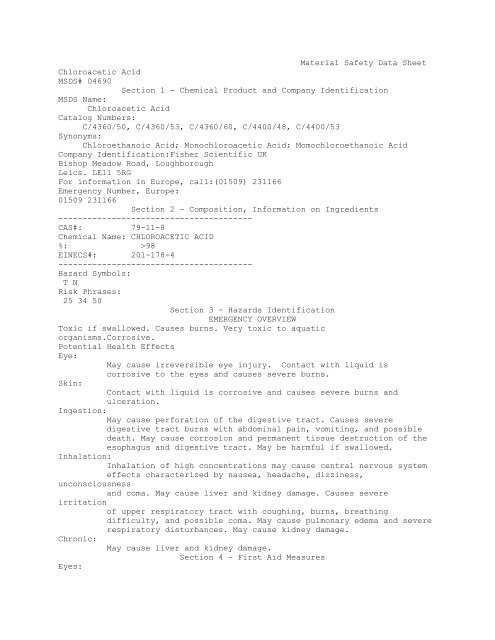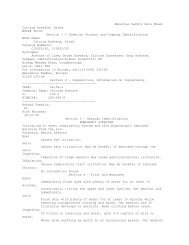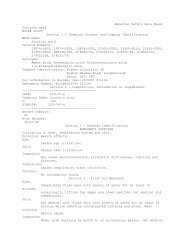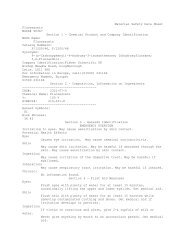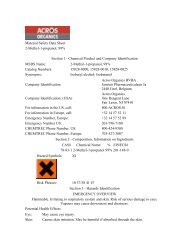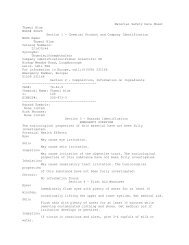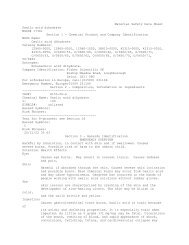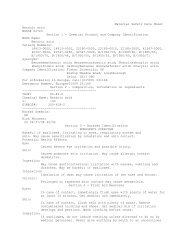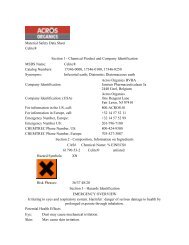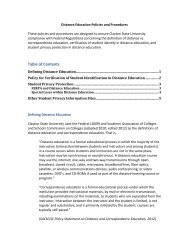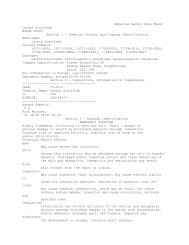Material Safety Data Sheet Chloroacetic Acid MSDS# 04690 Section 1
Material Safety Data Sheet Chloroacetic Acid MSDS# 04690 Section 1
Material Safety Data Sheet Chloroacetic Acid MSDS# 04690 Section 1
- No tags were found...
You also want an ePaper? Increase the reach of your titles
YUMPU automatically turns print PDFs into web optimized ePapers that Google loves.
<strong>Material</strong> <strong>Safety</strong> <strong>Data</strong> <strong>Sheet</strong><strong>Chloroacetic</strong> <strong>Acid</strong><strong>MSDS#</strong> <strong>04690</strong><strong>Section</strong> 1 - Chemical Product and Company IdentificationMSDS Name:<strong>Chloroacetic</strong> <strong>Acid</strong>Catalog Numbers:C/4360/50, C/4360/53, C/4360/60, C/4400/48, C/4400/53Synonyms:Chloroethanoic <strong>Acid</strong>; Monochloroacetic <strong>Acid</strong>; Momochloroethanoic <strong>Acid</strong>Company Identification:Fisher Scientific UKBishop Meadow Road, LoughboroughLeics. LE11 5RGFor information in Europe, call:(01509) 231166Emergency Number, Europe:01509 231166<strong>Section</strong> 2 - Composition, Information on Ingredients----------------------------------------CAS#: 79-11-8Chemical Name: CHLOROACETIC ACID%: >98EINECS#: 201-178-4----------------------------------------Hazard Symbols:T NRisk Phrases:25 34 50<strong>Section</strong> 3 - Hazards IdentificationEMERGENCY OVERVIEWToxic if swallowed. Causes burns. Very toxic to aquaticorganisms.Corrosive.Potential Health EffectsEye:May cause irreversible eye injury. Contact with liquid iscorrosive to the eyes and causes severe burns.Skin:Contact with liquid is corrosive and causes severe burns andulceration.Ingestion:May cause perforation of the digestive tract. Causes severedigestive tract burns with abdominal pain, vomiting, and possibledeath. May cause corrosion and permanent tissue destruction of theesophagus and digestive tract. May be harmful if swallowed.Inhalation:Inhalation of high concentrations may cause central nervous systemeffects characterized by nausea, headache, dizziness,unconsciousnessand coma. May cause liver and kidney damage. Causes severeirritationof upper respiratory tract with coughing, burns, breathingdifficulty, and possible coma. May cause pulmonary edema and severerespiratory disturbances. May cause kidney damage.Chronic:May cause liver and kidney damage.<strong>Section</strong> 4 - First Aid MeasuresEyes:
Get medical aid immediately. Do NOT allow victim to rub eyes orkeepeyes closed. Extensive irrigation with water is required (at least30minutes).Skin:Get medical aid immediately. Immediately flush skin with plenty ofwater for at least 15 minutes while removing contaminated clothingand shoes. Wash clothing before reuse. Destroy contaminated shoes.Ingestion:Never give anything by mouth to an unconscious person. Get medicalaid immediately. Do NOT induce vomiting. If conscious and alert,rinse mouth and drink 2-4 cupfuls of milk or water.Inhalation:Get medical aid immediately. Remove from exposure and move to freshair immediately. If breathing is difficult, give oxygen. Do NOT usemouth-to-mouth resuscitation. If breathing has ceased applyartificial respiration using oxygen and a suitable mechanicaldevicesuch as a bag and a mask.Notes to Physician:<strong>Chloroacetic</strong> acid causes competitive inhibition of acetateoxidationand acetylates sulfhydryl residues in the liver and kidney.<strong>Section</strong> 5 - Fire Fighting MeasuresGeneral Information:During a fire, irritating and highly toxic gases may be generatedbythermal decomposition or combustion. Use water spray to keepfire-exposed containers cool. Wear appropriate protective clothingto prevent contact with skin and eyes. Wear a self-containedbreathing apparatus (SCBA) to prevent contact with thermaldecomposition products. Contact with metals may evolve flammablehydrogen gas. Containers may explode when heated. Combustiblematerial; may burn but does not ignite readily.Extinguishing Media:Water or foam may cause frothing. Use water spray to coolfire-exposed containers. Do NOT get water inside containers. Forsmall fires, use dry chemical, carbon dioxide, or water spray. Forlarge fires, use dry chemical, carbon dioxide, alcohol-resistantfoam, or water spray. Cool containers with flooding quantities ofwater until well after fire is out.<strong>Section</strong> 6 - Accidental Release MeasuresGeneral Information:Use proper personal protective equipment as indicated in <strong>Section</strong> 8.Spills/Leaks:Avoid runoff into storm sewers and ditches which lead to waterways.Clean up spills immediately, observing precautions in theProtectiveEquipment section. Avoid generating dusty conditions. Remove allsources of ignition. Provide ventilation. Do not get water insidecontainers. Cover with dry earth, dry sand, or other noncombustiblematerial followed with plastic sheet to minimize spreading andcontact with water.<strong>Section</strong> 7 - Handling and StorageHandling:
Storage:awayWash thoroughly after handling. Remove contaminated clothing andwash before reuse. Minimize dust generation and accumulation. Keepcontainer tightly closed. Do not get on skin or in eyes. Do notingest or inhale. Discard contaminated shoes.Store in a tightly closed container. Keep from contact withoxidizing materials. Store in a cool, dry, well-ventilated areafrom incompatible substances. Keep away from metals. Keep away fromreducing agents. Do not store in metal containers. Do not storenearalkaline substances.<strong>Section</strong> 8 - Exposure Controls, Personal ProtectionEngineering Controls:Facilities storing or utilizing this material should be equippedwith an eyewash facility and a safety shower. Use adequateventilation to keep airborne concentrations low.Exposure LimitsCAS# 79-11-8:United Kingdom, WEL - TWA: 0.3 ppm TWA; 1.2 mg/m3 TWAUnited Kingdom, WEL - STEL: 0.9 ppm STEL; 3.6 mg/m3 STELGermany: 1 ppm TWA; 4 mg/m3 TWAGermany: Skin absorberNetherlands: 1 ppm MAC; 4 mg/m3 MACRussia: 1 mg/m3 TWAPersonal Protective EquipmentEyes:Wear appropriate protective eyeglasses or chemicalsafety goggles as described by OSHA's eye and faceprotection regulations in 29 CFR 1910.133 or EuropeanStandard EN166.Skin:Wear appropriate protective gloves to prevent skinexposure.Clothing:Wear appropriate protective clothing to prevent skinexposure.Respirators:Follow the OSHA respirator regulations found in 29CFR 1910.134 or European Standard EN 149. Use aNIOSH/MSHA or European Standard EN 149 approvedrespirator if exposure limits are exceeded or ifirritation or other symptoms are experienced.<strong>Section</strong> 9 - Physical and Chemical PropertiesPhysical State:SolidColor:colorless or whiteOdor:acetic odorpH:1.93 (0.1M)Vapor Pressure:.75 mm Hg @ 20CViscosity:2.16 cp@70CBoiling Point:189 deg C ( 372.20F)Freezing/Melting Point: 62 deg C ( 143.60F)Autoignition Temperature: 470 deg C ( 878.00 deg F)Flash Point: 126 deg C ( 258.80 deg F)Explosion Limits: Lower:8.0.Explosion Limits: Upper:Not availableDecomposition Temperature: Not available
Solubility in water: Soluble in water.Specific Gravity/Density: 1.404 (water=1)Molecular Formula:C2H3ClO2Molecular Weight: 94.4728<strong>Section</strong> 10 - Stability and ReactivityChemical Stability:Stable at room temperature in closed containers under normalstorageand handling conditions.Conditions to Avoid:Incompatible materials, ignition sources, dust generation,moisture,metals, excess heat.Incompatibilities with Other <strong>Material</strong>sNot availableHazardous Decomposition ProductsCarbon monoxide, irritating and toxic fumes and gases, carbondioxide.Hazardous PolymerizationHas not been reported.<strong>Section</strong> 11 - Toxicological InformationRTECS#:CAS# 79-11-8: AF8575000LD50/LC50:CAS# 79-11-8: Inhalation, rat: LC50 = 180 mg/m3; Oral,rat: LD50 = 55 mg/kg;.Carcinogenicity:CHLOROACETIC ACID -Not listed as a carcinogen by ACGIH, IARC, NTP, or CA Prop 65.Other:See actual entry in RTECS for complete information.<strong>Section</strong> 12 - Ecological InformationEcotoxicity:Not available<strong>Section</strong> 13 - Disposal ConsiderationsProducts considered hazardous for supply are classified as SpecialWaste and the disposal of such chemicals is covered by regulationswhich may vary according to location.Contact a specialist disposal company or the local authority oradvice. Empty containers must be decontaminated before returning forrecycling.<strong>Section</strong> 14 - Transport InformationIATAShipping Name:CHLOROACETIC ACID, SOLIDHazard Class: 6.1UN Number: 1751Packing Group:IIIMOShipping Name:CHLOROACETIC ACID, SOLIDHazard Class: 6.1UN Number: 1751Packing Group:IIRID/ADRShipping Name:CHLOROACETIC ACID, SOLIDHazard Class: 6.1UN Number: 1751Packing Group:II
USA RQ: CAS# 79-11-8: 1 lb statutory RQ; 0.454 kg statutory RQ; 100 lb finalRQ;<strong>Section</strong> 15 - Regulatory InformationEuropean/International RegulationsEuropean Labeling in Accordance with EC DirectivesHazard Symbols: T NRisk Phrases:R 25 Toxic if swallowed.R 34 Causes burns.R 50 Very toxic to aquatic organisms.<strong>Safety</strong> Phrases:S 23 Do not inhale gas/fumes/vapour/spray.S 37 Wear suitable gloves.S 45 In case of accident or if you feel unwell, seekmedical advice immediately (show the label wherepossible).S 61 Avoid release to the environment. Refer tospecial instructions/safety data sheets.WGK (Water Danger/Protection)CAS# 79-11-8: 2CanadaCAS# 79-11-8 is listed on Canada's DSL ListUS FederalTSCACAS# 79-11-8 is listed on the TSCA Inventory.<strong>Section</strong> 16 - Other InformationMSDS Creation Date:2/09/1999Revision #4 Date10/03/2005The information above is believed to be accurate and represents thebest information currently available to us. However, we make nowarranty of merchantibility or any other warranty, express orimplied, with respect to such information, and we assume no liabilityresulting from its use. Users should make their own investigations todetermine the suitability of the information for their particularpurposes. In no event shall the company be liable for any claims,losses, or damages of any third party or for lost profits or anyspecial, indirect, incidental, consequential, or exemplary damageshowsoever arising, even if the company has been advised of thepossibility of such damages.--------------------------------------------------------------------------------


